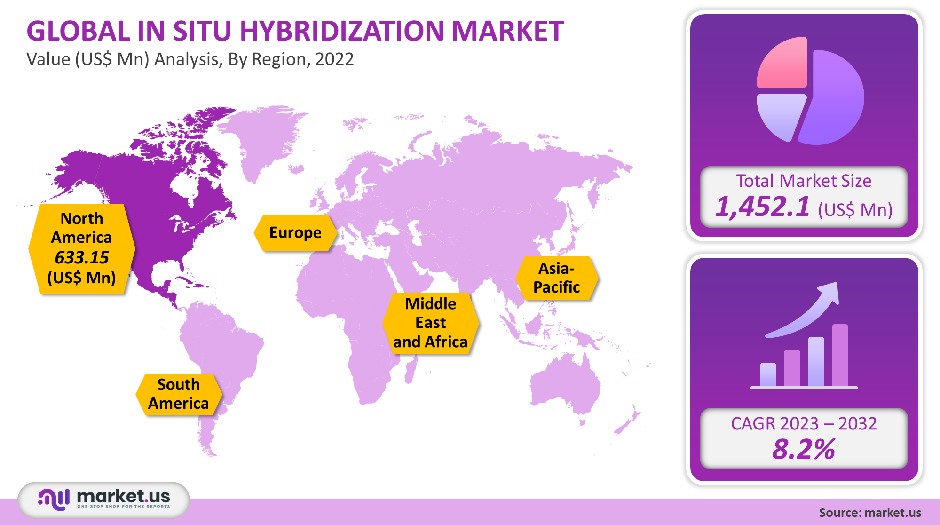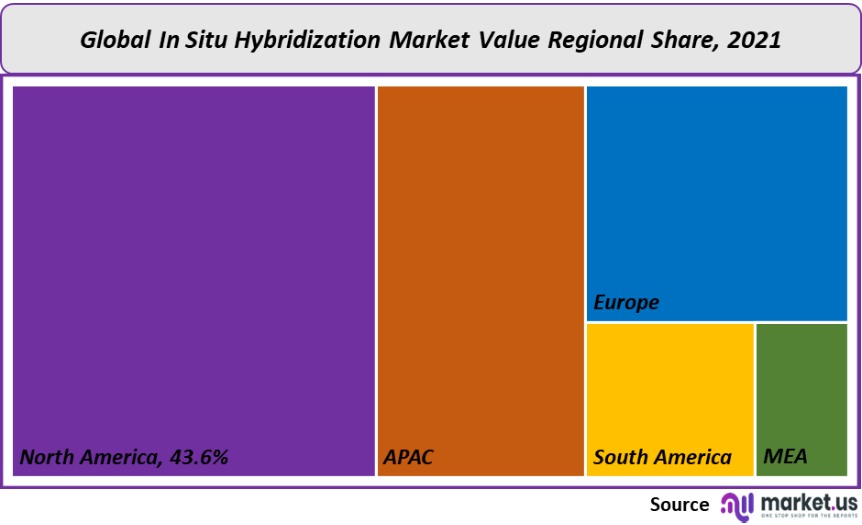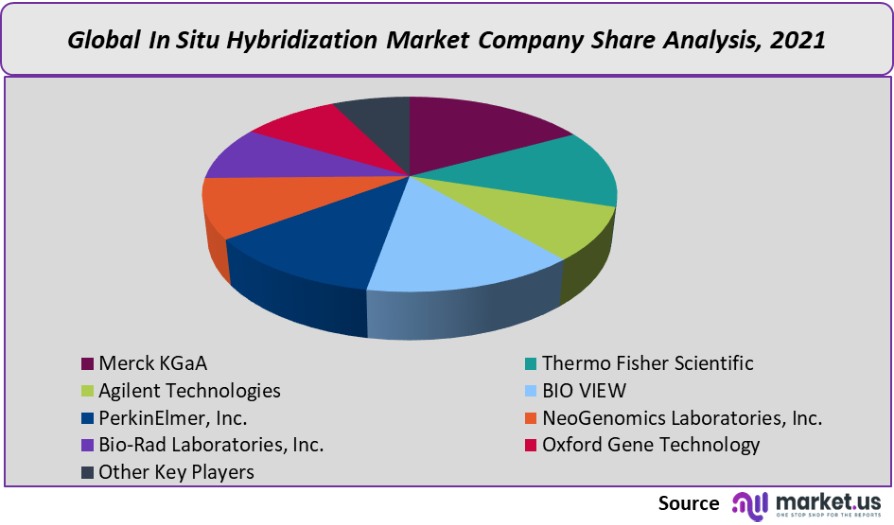Global In-Situ Hybridization Market By Product (Instruments, Kits & Probes, and Others), By Technology (Fluorescent In-Situ Hybridization, Chromogenic In-Situ Hybridization), By Probe Type (DNA, RNA), By Application (Cancer, Cytogenetics, Developmental Biology Infectious Diseases, Others), By End-Use (Hospitals & Diagnostic Laboratories, CROs, Others), By Region and Companies - Industry Segment Outlook, Market Assessment, Competition Scenario, Trends and Forecast 2022-2032
- Published date: Aug 2022
- Report ID: 35658
- Number of Pages: 285
- Format:
- keyboard_arrow_up
In situ Hybridization Market Overview:
The Global In-Situ hybridization market accounted for USD 1,452.1 million by 2021. This market is expected CAGR of 8.2% between 2023-2032.
Market growth can be driven by increasing awareness of target disorders, investments in the in-vitro diagnosis space, and technological advancements made in In-Situ hybridization.
Global In-Situ Hybridization Market Scope:
Product analysis
In-Situ hybridization is dominated by instruments, accounting for 38.5% revenue share in 2021. The rising number of diagnostic and research labs is the reason for increasing demand. In-Situ hybridization is expected to grow because of the increased number of strategic initiatives taken by players to expand their product range.
Bio-Techne Corporation has announced that they will introduce RNAscope technology and new DNA scope tests to the commercial market in April 2021. It will detect DNA’s copy number variations and structure variations. This would boost the market growth.
However, services will see significant growth in the in-situ hybridization market. The lucrative CAGR for this segment is being driven by increasing outsourcing to improve operational functionalities and ensure strict quality standards. This trend has led to many CROs offering in-situ hybridization services as part of their portfolio.

Technology analysis
The FISH segment, based on technology, conquered the In-Situ hybridization market and held the major revenue share at 55.6% in 2021. This is due to the broad range of applications like diagnosing congenital conditions such as Down’s Syndrome and Edward’s Syndrome. FISH technology is being used more frequently due to the rising numbers of these diseases and their analysis. It is expected that this will accelerate the growth of the segment.
CISH has also seen a substantial share of in-situ hybridization, as it is an affordable, reliable, and practical alternative to FISH. CISH technology is able to detect HER-2/neu copies using conventional peroxidase reactions.
CISH technology will be accepted more widely for HPV genotyping on cervical smears. The market is expected to grow further over the forecast period. The segment growth is driven by technological advancements in ISH.
In May 2021, researchers published their study, which showed that the chromogen-based RNA-In-Situ hybridization approach is a reliable method to detect drug-gable substances in psoriasis and atopic dermatitis. Technological advancements increase the reach of in-situ hybridization and stimulate segment growth.
Probe Type analysis
The in-Situ hybridization market was dominated by DNA probes, accounting for 53.1% revenue share in 2021. The RNA probe had a faster growth rate than the DNA probe segment, thanks to the advancement of nucleic acids-based diagnostic assays, tools, and methods for analyzing DNA and RNA molecules. An RNA probe is used for hybridization to detect the presence or absence of complementary nucleic acid sequences.
RNA probes are becoming increasingly popular as a tool for hybridization. They can be used to detect the presence of complementary nucleic acid sequences by hybridization and can be replaced with DNA probes in almost any application. It is possible to explain the high CAGR of 2021-2028 because RNA has a single-stranded signal that is more reliable than DNA probes. The ISH market will grow if there is more development in probe-based technology.
In July 2020, the US FDA approved the Ventana HER2 ISH Dual DNA Probe Cocktail assay to detect HER2 in breast cancer.
Application analysis
In-Situ hybridization is a market that dominates the cancer segment. It accounted for the largest revenue share at 37.9% in 2021. It is expected that the growth will be driven by the rising incidence of cancer cases. According to the American Cancer Society, approximately 1.9 Million new cases of cancer will be reported in the U.S. by 2021.
Due to an increase in cancer cases, In-Situ hybridization techniques are becoming more important for efficient and rapid diagnosis.
Cancers can be caused by unhealthy lifestyles, aging populations, environmental factors, and health conditions. Numerous organizations support research into cancer treatment and encourage further development. In 2020-21, the American Institute for Cancer Research provided approximately USD 110 million in funding for cancer research through its grant program.
End-Use analysis
Hospitals and diagnostic laboratories dominated the In-Situ hybridization market and held the largest revenue share at 51.1% in 2021. There are three major end users in the market: hospitals and diagnostic laboratories, and academic and research institutes. The current pandemic could be a key driver for laboratories, as the ability to understand the pathogen and offer competitive advantages to them can help to lead the industry.
Although the absolute value is lower than other segments, the Contract Research Organizations market is growing at an even faster rate. Many organizations outsource clinical trials and research to research laboratories. Factors like a specialized workforce can reduce costs for companies. Companies may also be motivated by improving efficiency to outsource their research.
Кеу Маrkеt Ѕеgmеntѕ
By Product
- Software
- Instruments
- Services
- Kits & Probes
By Technology
- Fluorescent In-Situ Hybridization(FISH)
- Chromogenic In-Situ Hybridization(CISH)
By Probe Type
- RNA
- DNA
By Application
- Cytogenetics
- Cancer
- Infectious Diseases
- Developmental Biology
- Others
By End-Use
- CROs
- Hospitals & Diagnostic Laboratories
- Academic& Research Institutes
- Others
Market Dynamics:
The ISH market’s growth was also influenced by the COVID-19 epidemic. The University of Oxford and the University of Warwick teamed up to discover a way to detect the COVID-19 virus within 20 minutes by In-Situ hybridization. This technology has been used in the past to detect infection within cells, such as HIV or Epstein-Barr. Market growth is expected to be driven by such developments in the near future.
In recent years, many research institutions and organizations have invested in R&D to develop a technology for determining the molecular profile of single cells. Bio-protocol, for instance, developed an In-Situ hybridization technique called Proximity Ligation and In-Situ Hybridization. It is easy to use and low in cost.
Accessibility to affordable in-situ hybridization technology improves for developing countries that are vulnerable to disease and infection. In order to raise awareness among the public, regulators have developed a range of initiatives and policies. To spread awareness about infectious diseases, the WHO and Federal Capital Territory Public Health Department (Nigeria) collaborated in August 2021.
Recent years have seen an increase in ISH product use, which has resulted in an increase in specialized contract research organizations. This increased market competition. Reveal Biosciences provides services such as tissue research and advanced tissue technology services through In-Situ hybridization, among other methods. It adheres to strict legislative requirements.
Regional Analysis
North America dominated In-Situ Hybridization in 2021, accounting for 43.6% revenue share. This region has seen significant growth due to the presence of many market players and the incentivized research projects of the regional government. Other factors that contributed to the dominance in the region are high healthcare expenditures and strict regulations by FDA and Health Canada.
North America holds the largest number of patents. The Asia Pacific has a larger marginal growth than other regions. The market will be supported by Health Canada through research projects and institutions.
The Asia Pacific will likely see the most rapid growth during the forecast period. The market’s key driver is expected to be R&D. China and India are among the fastest-growing countries in the Asia Pacific region.

Key Regions and Countries covered іn thе rероrt:
- North America
- US
- Canada
- Mexico
- Europe
- Germany
- UK
- France
- Italy
- Russia
- Spain
- Rest of Europe
- APAC
- China
- Japan
- South Korea
- India
- Rest of Asia-Pacific
- South America
- Brazil
- Argentina
- Rest of South America
- MEA
- GCC
- South Africa
- Israel
- Rest of MEA
Market Share & Key Players Analysis:
The market for in-situ hybridization is very competitive. Because of their vast product portfolios as well as geographic presence, some of the major players accounted for the largest market share. To lower operational expenses and increase profit margins, major players are looking at strategies such as channel enhancement, mergers, acquisitions, operational restructuring, and direct contracts with distributors. Some major key players are:

Маrkеt Кеу Рlауеrѕ:
- Merck KGaA
- Thermo Fisher Scientific
- Agilent Technologies
- BIO VIEW
- PerkinElmer, Inc.
- NeoGenomics Laboratories, Inc.
- Bio-Rad Laboratories, Inc.
- Oxford Gene Technology
- Other Key Players
For the In situ Hybridization Market research study, the following years have been considered to estimate the market size:
Attribute Report Details Historical Years
2016-2020
Base Year
2021
Estimated Year
2022
Short Term Projection Year
2028
Projected Year
2023
Long Term Projection Year
2032
Report Coverage
Competitive Landscape, Revenue analysis, Company Share Analysis, Manufacturers Analysis, Volume by Manufacturers, Key Segments, Key company analysis, Market Trends, Distribution Channel, Market Dynamics, COVID-19 Impact Analysis, strategy for existing players to grab maximum market share, and more.
Regional Scope
North America, Europe, Asia-Pacific, South America, Middle East & Africa
Country Scope
United States, Canada and Mexico, Germany, France, UK, Russia and Italy, China, Japan, Korea, India and Southeast Asia, Brazil, Argentina, Colombia etc.Saudi Arabia, UAE, Egypt, Nigeria and South Africa
Frequently Asked Questions (FAQ)
Q: What is the size of the In-Situ Hybridization market in 2021?A: The In-Situ Hybridization market size is US$ 1,452.1 million in 2021.
Q: What is the projected CAGR at which the In-Situ Hybridization market is expected to grow at?A: The In-Situ Hybridization market is expected to grow at a CAGR of 8.2% (2023-2032).
Q: List the segments encompassed in this report on the In-Situ Hybridization market?A: Market.US has segmented the In-Situ Hybridization market by geographic (North America, Europe, APAC, South America, and Middle East and Africa). By Product, market has been segmented into Instruments, Kits & Probes, Software, Services. By Technology, the market has been further divided Fluorescent In-Situ Hybridization, Chromogenic In-Situ Hybridization. By Probe Type, the market has been further divided into DNA, RNA. By Application, the market has been further divided into Cancer, Cytogenetics, Developmental Biology Infectious Diseases, Others. By End-Use, the market has been further divided into Hospitals & Diagnostic Laboratories, CROs, Academic& Research Institutes, Others.
Q: List the key industry players of the In-Situ Hybridization market?A: Merck KGaA, Thermo Fisher Scientific, Agilent Technologies, BIO VIEW, PerkinElmer, Inc., NeoGenomics Laboratories, Inc., Bio-Rad Laboratories, Inc., Oxford Gene Technology, and Other Key Players engaged in the In-Situ Hybridization market.
Q: Which region is more appealing for vendors employed in the In-Situ Hybridization market?A: North America accounted for the highest revenue share of 43.6%. Therefore, the In-Situ Hybridization industry in North America is expected to garner significant business opportunities over the forecast period.
Q: Name the key areas of business for In-Situ Hybridization?A: The US, Canada, Mexico, China, Japan, India and Others, are key areas of operation for In-Situ Hybridization Market.
Q: Which segment accounts for the greatest market share in the In-Situ Hybridization industry?A: With respect to the In-Situ Hybridization industry, vendors can expect to leverage greater prospective business opportunities through the Fluorescent In-Situ Hybridization segment, as this area of interest accounts for the largest market share.
![In situ Hybridization Market In situ Hybridization Market]() In situ Hybridization MarketPublished date: Aug 2022add_shopping_cartBuy Now get_appDownload Sample
In situ Hybridization MarketPublished date: Aug 2022add_shopping_cartBuy Now get_appDownload Sample - Merck KGaA Company Profile
- Thermo Fisher Scientific Company Profile
- Agilent Technologies Inc. Company Profile
- BIO VIEW
- PerkinElmer, Inc.
- NeoGenomics Laboratories, Inc.
- Bio-Rad Laboratories, Inc. Company Profile
- Oxford Gene Technology
- Other Key Players
- settingsSettings
Our Clients
|
Single User
$5,999
$2,999
USD / per unit
save 50% |
Multi User
$7,999
$3,499
USD / per unit
save 55% |
Corporate User
$12,999
$4,499
USD / per unit
save 65% | |
|---|---|---|---|
| e-Access | |||
| Data Set (Excel) | |||
| Company Profile Library Access | |||
| Interactive Dashboard | |||
| Free Custumization | No | up to 10 hrs work | up to 30 hrs work |
| Accessibility | 1 User | 2-5 User | Unlimited |
| Analyst Support | up to 20 hrs | up to 40 hrs | up to 50 hrs |
| Benefit | Up to 20% off on next purchase | Up to 25% off on next purchase | Up to 30% off on next purchase |
| Buy Now ($ 2,999) | Buy Now ($ 3,499) | Buy Now ($ 4,499) |









